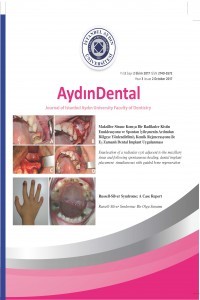DİŞ HEKİMLİĞİ FAKÜLTESİ ÖĞRENCİLERİNİN ORTODONTİK TEDAVİ BİLGİLERİNİN DEĞERLENDİRİLMESİ
Bilgi, Diş Hekimliği Öğrencisi, Ortodonti, Ortodontik tedavi., Yaşam Kalitesi
KNOWLEDGE OF ORTHODONTIC TREATMENT AMONG DENTAL STUDENTS
dental students, knowledge, orthodontics, orthodontic treatments, quality of life,
___
- 1-Richards MR et al. Contribution of malocclusion and female facial attractiveness to smile esthetics evaluated by eye tracking. Am J Orthod Dentofacial Orthop. 2015; 147(4): 472-482.
- 2-Diklić D, Sever EK, Galić N, Spajić J, Prskalo K. Attitudes of Students of Differenet Schools of University of Zagreb on Tooth Bleaching. Acta Stomatol Croat. 2016 Dec;50(4):301-309. doi: 10.15644/asc50/4/3.
- 3- KO Adegbite, BO Ogunbanjo, OA Ajisafe, and AA Adeniyi1 Knowledge of Orthodontics as a Dental Specialty: A Preliminary Survey among LASUCOM Students Ann Med Health Sci Res. 2012 Jan-Jun; 2(1): 14–18.
- 4-Chen M, Wang DW, Wu LP. Fixed orthodontic appliance therapy and its impact on oral health-related quality of life in Chinese patients. Angle Orthod. 2010;80(1):49-55.
- 5-Klages U, Bruckner A, Guld Y, Zentner A. Dental esthetics, orthodontic treatment,and oral-health attitudes in young adults. Am J Orthod Dentofacial Orthop.2005;128(4):442-449.
- 6-Liu Z, McGrath C, Hägg U. The impact of malocclusion/orthodontic treatment need on the quality of life: a systematic review. Angle Orthod. 2009;79(3):585-591.
- 7- Pandey M, Singh J, Mangal G, Yadav P. Evaluation of awareness regarding orthodontic procedures among a group of preadolescents in a cross-sectional study. J Int Soc Prev Community Dent. 2014 Jan-Apr; 4(1): 44–47.
- 8-Prabhakar RR, Saravanan R, Karthikeyan MK, Vishnuchandran C, Sudeepthi. Prevalence of malocclusion and need for early orthodontic treatment in children. J Clin Diagn Res. 2014 May;8(5):ZC60-1.
- 9-Baykul, Y. (2000). Eğitimde ve Psikolojide Ölçme: Klasik test Teorisi ve Uygulaması. ÖSYM Yayınları, Ankara.
- 10- Ertürk, S. (2013) Eğitimde “Program” Geliştirme. Edge Akademi.
- 11-Salzman JD. Patient cooperation and assessment. Br Dent J. 1973;134:91–4.
- 12-Albino JE, Lawrence SD, Tedesco LA. Psychological and social effects of orthodontic treatment. J Behav Med. 1994;17(1):81-98
- 13- Heydecke G, Gobetti JP. Oral Health Related Quality of Life. Chicago, Quintessence Publishing Co Inc, 2002.
- 14- Naito M, Yuasa H, Nomura Y. Oral health status and health-related quality of Life: a systematic review. Journal of Oral Science. 2006;48:1-7.
- 15-de Oliveira CM, Sheiham A. The relationship between normative orthodontic treatment need and oral health-related quality of life. Community Dent Oral Epidemiol. 2003;31(6):426-36.
- 16- de Oliveira CM, Sheiham A. Orthodontic treatment and its impact on oral health related quality of life in Brazilian adolescents. J Orthod. 2004;31(1):20-27.
- 17- Gherunpong S, Tsakos G, Sheiham A. A socio-dental approach to assessing children's orthodontic needs. Eur J Orthod. 2006;28(4):393-399.
- 18-Marques LS, Ramos-Jorge ML, Paiva SM, Pordeus IA. Malocclusion: esthetic impact and quality of life among Brazilian schoolchildren. Am J Orthod Dentofacial Orthop. 2006;129(3):424-427.
- 19-Feu D, de Oliveira BH, Almeida MAO, Kiyak HA, Miguel JAM. Oral health-related quality of life and orthodontic treatment seeking. Am J Orthod Dentofacial Orthop. 2010;138(2):152-159.
- 20-Liu Z, McGrath C, Hägg U. The impact of malocclusion/orthodontic treatment need on the quality of life: a systematic review. Angle Orthod. 2009;79(3):585-591.
- 21-Feldmann I, List T, John MT, Bondemark L. Reliability of a questionnaire assessing experiences of adolescents in orthodontic treatment. Angle Orthod. 2007;77:311–317.
- 22-Fonseca LM, Araújo TM, Santos AR, Faber J. Impact of metal and ceramic fixed orthodontic appliances on judgments of beauty and other face-related attributes. Am J Orthod Dentofacial Orthop. 2014 Feb;145(2):203-6.
- 23-Papageorgiou SN, Gölz L, Jäger A, Eliades T, Bourauel C. Lingual vs. labial fixed orthodontic appliances: systematic review and meta-analysis of treatment effects. Eur J Oral Sci. 2016 Apr;124(2):105-18.
- 24-Kim Y. Study on the perception of orthodontic treatment according to age: A questionnaire survey. Korean J Orthod. 2017 Jul;47(4):215-221.
- ISSN: 2149-5572
- Yayın Aralığı: Yılda 3 Sayı
- Başlangıç: 2015
- Yayıncı: İstanbul Aydın Üniversitesi
PEDİATRİK DİŞ HEKİMLİĞİNDE LEZYON STERİLİZASYONU VE DOKU TAMİRİ
Berk ŞENGÜLER, Venus SEYEDOSKUYİ, Gizem AKKUŞ, Başak AKDAĞ, Ekin DOĞAN, Akif ASLANTAŞ, Aslı TOPALOĞLU AK
AKUT MİYELOİD LÖSEMİDE GÖZLENEN ORAL KOMPLİKASYONLAR
Saadet ÇINARSOY CİĞERİM, Jamıl BAYZED, Yousef M K SAED, Hüseyin Melik BÖYÜK
DİŞ HEKİMLİĞİ FAKÜLTESİ ÖĞRENCİLERİNİN ORTODONTİK TEDAVİ BİLGİLERİNİN DEĞERLENDİRİLMESİ
Gülşilay SAYAR, Delal Dara KILINÇ
DİŞ HEKİMLİĞİNDE KULLANILAN YÜKSEK PERFORMANSLI POLİ-ARİL-ETER-KETON (PAEK) POLİMERLERİ
Verda Gökçe ÇAKAR, İbrahim Halil TACİR, Zelal SEYFİOĞLU POLAT
TÜRKİYE'DE ORTODONTİ İLE İLGİLİ İNTERNET VERİLERİNİN DEĞERLENDİRİLMESİ: GOOGLE TRENDS ANALİZİ
Ömer Faruk SARI, Muhammed Hilmi BUYUKCAVUS, Burak KALE, Hikmet ORHAN
Metehan YILMAZ, Esra Özge AYDIN, Berkay Enes GÜNGÖR, Ongun ÇELİKKOL, Umut YİĞİT
